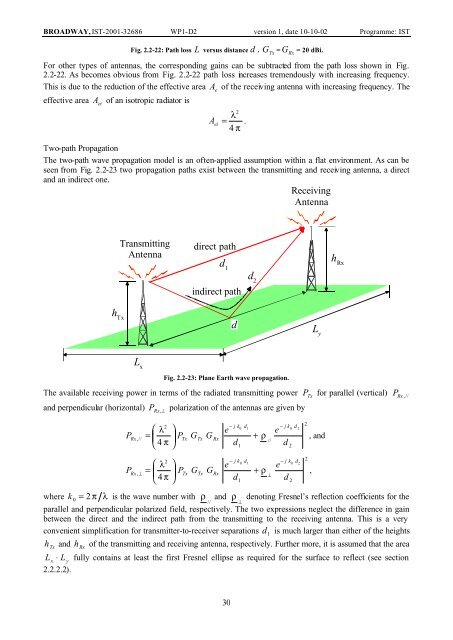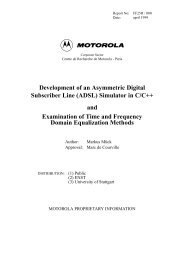WP 1, D2 – Functional System Parameters description
WP 1, D2 – Functional System Parameters description
WP 1, D2 – Functional System Parameters description
You also want an ePaper? Increase the reach of your titles
YUMPU automatically turns print PDFs into web optimized ePapers that Google loves.
BROADWAY, IST-2001-32686 <strong>WP</strong>1-<strong>D2</strong> version 1, date 10-10-02 Programme: ISTFig. 2.2-22: Path loss L versus distance d .GTx = GRx = 20 dBi.For other types of antennas, the corresponding gains can be subtracted from the path loss shown in Fig.2.2-22. As becomes obvious from Fig. 2.2-22 path loss increases tremendously with increasing frequency.This is due to the reduction of the effective area Aeof the receiving antenna with increasing frequency. Theeffective area Aeiof an isotropic radiator is2λAei= .4 πTwo-path PropagationThe two-path wave propagation model is an often-applied assumption within a flat environment. As can beseen from Fig. 2.2-23 two propagation paths exist between the transmitting and receiving antenna, a directand an indirect one.ReceivingAntennaTransmittingAntennadirect pathd 1d 2h Rxindirect pathh TxdL yL xFig. 2.2-23: Plane Earth wave propagation.The available receiving power in terms of the radiated transmitting power PTxfor parallel (vertical) PRx, //and perpendicular (horizontal) PRx, ⊥polarization of the antennas are given byPRx,//2− j k0d1⎛ λ ⎞e= ⎜ ⎟ P G G + ρ⎝ ⎠− j k 0 d 2Tx Tx Rx//4 πd1d2e2, andP⎛ ⎞e= ρ⊥⎝ 4 ⎠d2− j k 0 d1λeRx,⊥⎜ ⎟ PTxGTxGRx+πd1− j k0d2where k = 2π 0λ is the wave number with ρ and ρ denoting Fresnel’s reflection coefficients for the//⊥parallel and perpendicular polarized field, respectively. The two expressions neglect the difference in gainbetween the direct and the indirect path from the transmitting to the receiving antenna. This is a veryconvenient simplification for transmitter-to-receiver separations d1is much larger than either of the heightshTxand hRxof the transmitting and receiving antenna, respectively. Further more, it is assumed that the areaLx ⋅ L yfully contains at least the first Fresnel ellipse as required for the surface to reflect (see section2.2.2.2).22,30






